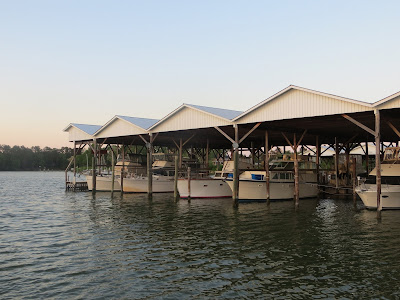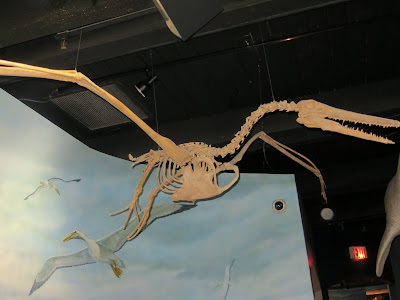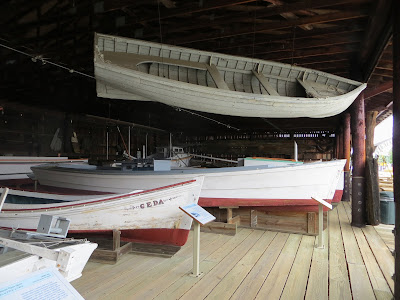We left our anchorage at St. Marys with a short 15-mile run to the Corinthian Yacht Club (CYC) in Ridge, MD, close to the mouth of the Potomac River. CYC is celebrating its 110th anniversary and offered a special for Loopers traveling through. Also, it has been nicknamed "The Jewel Of The Potomac" so we figured it was definitely worth a stop. Leaving the anchorage, we caught a couple of scullers from the college out on their morning run.
And a couple of local fishermen working their traps.
Here's the arrival into CYC and an aerial view from one of their pictures inside the clubhouse. They have 21 acres out on a point with several sets of docks. It's quite a nice setting and their rates are reasonable also.
CYC has an interesting history with its original charter location being in Washington, D.C. JFK was a former member and Calvin Coolidge once presented the Presidents Cup Trophy there.
CYC has an historic 6-foot wheel on display from the USS Modanock, in service from 1864 to 1919.
They gave us a choice of outside or covered docks. We chose covered since heavy rain was in the forecast. Covered slips are the norm back on our home territory of the Tennessee River, but this is the first time Help Me Rhonda has been under cover in about 2 and 1/2 years when we managed the marina in Muskogee, OK!
These pictures do not do justice to the quiet and serenity here. The club also gave us full access to the clubhouse - a large three bedroom house with a full commercial kitchen, dining room, library/television room, casual sitting area, laundry, etc. The pool will open this coming weekend. Members offered us the use of their cars and even left the keys to an extra vehicle when they went home. This is a wonderful, welcoming marina.
As usual, we took a bike ride into "town" - in this case it was Ridge, MD. Not much there but we were very impressed with the memorial to deceased volunteer firemen in the area.
The only other recommendations we got were a park with a monument to a Catholic school for improving educational opportunities for blacks and a historic church. Here's the monument to the school.
The Maryland countryside is quite beautiful - lots of farmland.
We stayed at CYC for 3 days waiting for winds on the Chesapeake to die down a bit. We finally left this morning at 5:45 to get ahead of higher wind in the afternoon. That's earlier than normal for us but the sunrise was pretty nice.
There was another large marker/lighthouse on the way to Solomons named "Point No Point." You can see how choppy the water was, even early in the morning. We had 1 to 2 foot seas most of the way.
As you approach Solomons from the south, you pass Patuxent Naval Air Station on your port side and in the distance you can see some very tall cliffs. These cliffs have produced many artifacts, sharks teeth in particular, and fossils over the years.
We docked at Calvert Marine and were greeted by a really nice family from Annapolis - they had just bought a new boat and had come to Solomons for Mother's Day weekend. The two kids, Coral Ann (boat named for her) and Gordon (dinghy named for him), were precious and reminded us of our grandkids. We saw them again later at a local museum, thus the ticket sticker on Coral Ann's nose!
The museum was pretty impressive and much of the info and displays were focused on the same themes of the cliffs mentioned above - early creatures, fossils, and artifacts. Here are a couple of the early ones.
There were lots of neat birds and animals on display.
And fish of course - we loved the seahorses.
The next section was dedicated to agriculture and the fishing industry. Tobacco farming was the focus in agriculture. Rhonda's family has some history and experience in this area. Much of her Dad's family's land produced tobacco in the Wilson, NC area. Rhonda says she has even hung a little tobacco herself at her Granny's farm.
In the early days, tobacco was shipped in barrels called "hogsheads." There's about one acre of tobacco in this hogshead. The standard size of these was 48" tall and 36" in diameter.
The museum also has many interesting and varied styles of boats from the 1800s. This small craft collection of working boats includes crabbing skiffs, jolly boats, river dorys, and buyboats. There were also pre-colonial and colonial era dug-out canoes.
Rhonda's favorite was the Wm. B. Tennyson buyboat.
Here is the story.
The highlight of the museum was the Drum Point Lighthouse which was originally placed in operation 120 yards offshore in 1883. It was replaced by a mechanical light and decommissioned in 1962, moved to the museum in 1975, and opened to the public in 1978 after extensive reconstruction. Before the lighthouse was moved, the area around it completely shoaled in to the point that you could walk all the way out to it.
During the course of its 79 years of operational use, it had 19 keepers, most of whom had families living there with them until 1944 when that option ended. Speaking of "growing up on the water" - that's literally the case for the kids of those families. School-age children were picked up by boat to attend school. Here are some shots of the inside.
That's a bedside potty chair in the corner in the picture above and a chamber pot at the end of the bed in the picture below. Everything went over the outside rail when you were done!
Rainwater was collected from the roof and kept in large 200-gallon drums inside the house. Collection spouts were kept closed until the rain had a chance to wash the roof - something about all of those sea gulls and roofs!
Here's the bellringer which was used during fog. It had to be manually rewound every 2 hours and rang twice every 15 seconds. Some of the keepers pointed out that you didn't get much sleep on those nights.
Here's the Fresnel lens which shone as a white and red navigation light. It was lit originally by a kerosene lamp.
Solomons and Solomons Island are pretty much lots of boats and a lot more boats, a few restaurants, a little bit of shopping, and a few pretty homes.
We finally got back to the marina and decided to borrow the courtesy car to buy some groceries. Marina courtesy cars are an interesting story. They are usually pretty rough and we have seen some doosies. Probably the worst was one with a rusted-out floorboard where you could actually see the road passing by underneath you. This one is the first Mercedes we've seen. One of the other folks at the marina called it the "death trap." It was actually pretty nice in my opinion with only 225,000 miles.
It's the interiors that usually have some interesting finds and aids. Here's a sticky label giving instructions on moving the seat.
And some duct tape that says "Do Not Touch" but it's not clear what you are not to touch. It's a little hard to read and definitely needs a new duct tape update! We definitely appreciate the marinas that go out of their way to provide cars for boaters.
We topped the fuel tank off on the way out of Solomons - last chance to get anything close to reasonably priced fuel before continuing up the coast into NJ and NY. We are crossing the Chesapeake Bay on this next stretch to check out the east side. We'll be on the Choptank River and visiting "the most picturesque town on the Chesapeake" - Oxford, MD. See you there.













































No comments:
Post a Comment